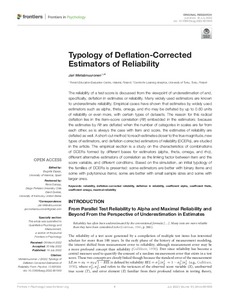Typology of Deflation-Corrected Estimators of Reliability
Metsämuuronen Jari
Typology of Deflation-Corrected Estimators of Reliability
Metsämuuronen Jari
FRONTIERS MEDIA SA
Julkaisun pysyvä osoite on:
https://urn.fi/URN:NBN:fi-fe2022091258687
https://urn.fi/URN:NBN:fi-fe2022091258687
Tiivistelmä
The reliability of a test score is discussed from the viewpoint of underestimation of and, specifically, deflation in estimates or reliability. Many widely used estimators are known to underestimate reliability. Empirical cases have shown that estimates by widely used estimators such as alpha, theta, omega, and rho may be deflated by up to 0.60 units of reliability or even more, with certain types of datasets. The reason for this radical deflation lies in the item-score correlation (Rit) embedded in the estimators: because the estimates by Rit are deflated when the number of categories in scales are far from each other, as is always the case with item and score, the estimates of reliability are deflated as well. A short-cut method to reach estimates closer to the true magnitude, new types of estimators, and deflation-corrected estimators of reliability (DCERs), are studied in the article. The empirical section is a study on the characteristics of combinations of DCERs formed by different bases for estimators (alpha, theta, omega, and rho), different alternative estimators of correlation as the linking factor between item and the score variable, and different conditions. Based on the simulation, an initial typology of the families of DCERs is presented: some estimators are better with binary items and some with polytomous items; some are better with small sample sizes and some with larger ones.
Kokoelmat
- Rinnakkaistallenteet [19250]
